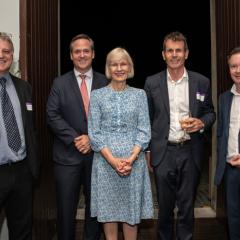Ups and downs: latest data for two multi-year UQ research studies released
The latest results from two multi-year studies into what happens when gas comes to town points to the beginnings of a much awaited stabilisation phase and slowly improving levels of trust in the CSG industry.
The University of Queensland (UQ) took the results of the latest research on the road, holding workshops in Roma, Miles, Chinchilla, Dalby and Toowoomba last week to disseminate the findings. 120 people attended the workshops, presented by Dr Kathy Witt, the lead researcher in UQ’s socio-economic indicators research, and Professor Nicole Gillespie who lead UQ’s trust in CSG research.
ROLE OF NATURAL GAS IN TRANSITION TO LOWER EMISSIONS FUTURE
Each workshop started with an overview of the latest forecasts from the world’s peak energy body, the International Energy Agency (IEA). It forecasts that to achieve lower global emissions, natural gas production may need to grow to account for a quarter of energy demand by 2040.
Using natural gas for energy production, when production processes are optimised, produces significantly less greenhouse gas emissions than other fossil fuels. The main IEA scenarios (even the ones which result in major global emissions reductions) require natural gas to have a key a role in supporting the journey towards lower emissions . Furthermore, while the role of gas for energy in the generation of electricity is usually front of mind, it is often forgotten that it is also the principle constituent in over 80% of the world’s nitrogen fertilisers. The IEA also see this need continuing into the future as the population heads above 9 billion before 2050.
Australia’s gas resources create the potential for the country to be a major global supplier of natural gas to help meet the increasing demand for affordable energy over the transition decades. Dr Witt said that UQ’s Centre for Coal Seam Gas was tasked with research into optimising the natural gas sector in terms of environmental (especially groundwater) performance, social performance, and optimisation of cost of operation and supply.
REGIONAL INDICATORS
Dr Witt then presented the latest results of the community indicators project. The University of Queensland Centre for Coal Seam Gas was tasked with conducting this research in 2012. A world-leading online toolkit was developed in consultation with community members to assess how gas development impacts regional development and shapes rural communities. It is being used to show the town-level changes in the Queensland gasfield regions, by assessing trends using interviews and statistical data on key indicators. These indicators include population, housing costs, income, unemployment, tourism and crime rates and have been put forward as being meaningful by community members and other stakeholders.
“Having a tool to source and analyse this information helps to provide an understanding of each town studied and an understanding of the region as a system,” says Dr Witt.
“These understandings can feed into decision making aimed at improving outcomes for each community and the region’s future.”
The project sources public data from a range of collection points such as the Australian Bureau of Statistics, Australian Taxation Office and Queensland Police Service. This is then ground-truthed with a series of in-depth interviews with local community members across the local industries in each of the areas studied. “The data gives an overarching picture, but statistics don’t tend to pick up the nuances of local experience,” explains Dr Witt. “With this process we can see overarching trends, then use the interviews to capture the richness and complexities of local experiences,” she explains. “This is important because every town and community is different. Within each industry there are a broad spectrum of experiences.”
This is the fifth year that Dr Witt’s socio-economic research has been undertaken, which has meant it has successfully mapped change in the studied areas over time. Dr Witt says at a high level the latest data indicates a turnaround in unemployment, rents and crime.
“The data indicates we’ve seen a boom and a quick cessation and the communities now appear to be in a new phase as indicators stabilise or return to trend,” she says. “It is important to keep in mind that it is not as simple as that - while some indicators are pointing to improvements, we know there are individual businesses in these towns doing it tough.”
Dr Witt reported that there was strong discussion in each of the locations about the issues the community and farmers had experienced in the early days of gas coming to town. “Some remain firmly opposed to the industry, while for others, it is now just part of the mix. The conversations have changed over the years – they are more about how to co-exist with the gas industry. Interestingly, we’ve heard several reports from people who believe that having the gas industry in the region gas helped to buffer the full economic effects of the drought for town economies.”
Dr Witt says that the research shows the towns studied are still agricultural towns at their core. “These are agricultural towns with gas, not gas towns per se. They are not resource dependent - they are more diversified - a lot of the issues faced are still underpinned and heavily influenced by the local agricultural sector.”
The data from the latest research round has been added to the project website where people can look up data for their towns and even benchmark their results against other nearby towns: https://boomtown-indicators.org/
TRUST
Professor Nicole Gillespie then led the audience through the latest research results on stakeholder trust in CSG. She presented the latest survey results benchmarked against the survey findings in 2015.
“This year’s results show an increase in landholders’ trust in the CSG industry over time and more positive views of how the industry impacts on local communities. However, landholders still have the lowest trust in the industry of all stakeholder groups. By contrast, community trust in the CSG industry has remained largely stable over time, although communities generally perceive the impact of the industry on local communities to be less positive now than at the height of the ‘construction boom’. Regulators (including State government agencies and local governments) trust in the CSG industry increased significantly from 2015,” she reported.
“There is continued feedback that the industry’s support of local communities is central to changing levels of acceptance. Communities expect and call on the industry to upskill and employ local people, rather than relying on bringing in skilled workers from elsewhere.”
“There was a strong theme across each of the workshops of the importance of the ‘social licence to operate’ and the gas companies putting ‘genuine’ support back into local communities to ensure long term benefits. There were also calls for more research and monitoring on environmental impacts,” she said.
Professor Gillespie reported that other common feedback from workshop attendees was for the companies to be upfront and transparent about their plans.
The survey also included employees and contractors of gas companies. They report high trust in the industry and believe that progress has been made with making information about the industry and company operations more available. They called for greater education and understanding to help dispel ‘untruths’ and ‘misconceptions’ about the industry which are still circulating in many communities.
“We know so much more now about the practices that enhance and undermine trust, and how companies can meet landholder, community and regulatory expectations,” says Professor Gillespie. The key recommendations haven’t changed significantly since 2015. “Looking through the recommendations from survey participants, we find they are very similar to those given in 2015, with the exception that there is more focus on serving local and Australian interests and needs for gas supply and affordable energy.”
Headlines: Each town and industry within the town is responding differentlyPopulation
Business and Income
Employment
Housing
Wellbeing and Safety
|
The roadshow presented results of research, and as such does not reflect the views of UQ or the members of the Centre for Coal Seam Gas.



